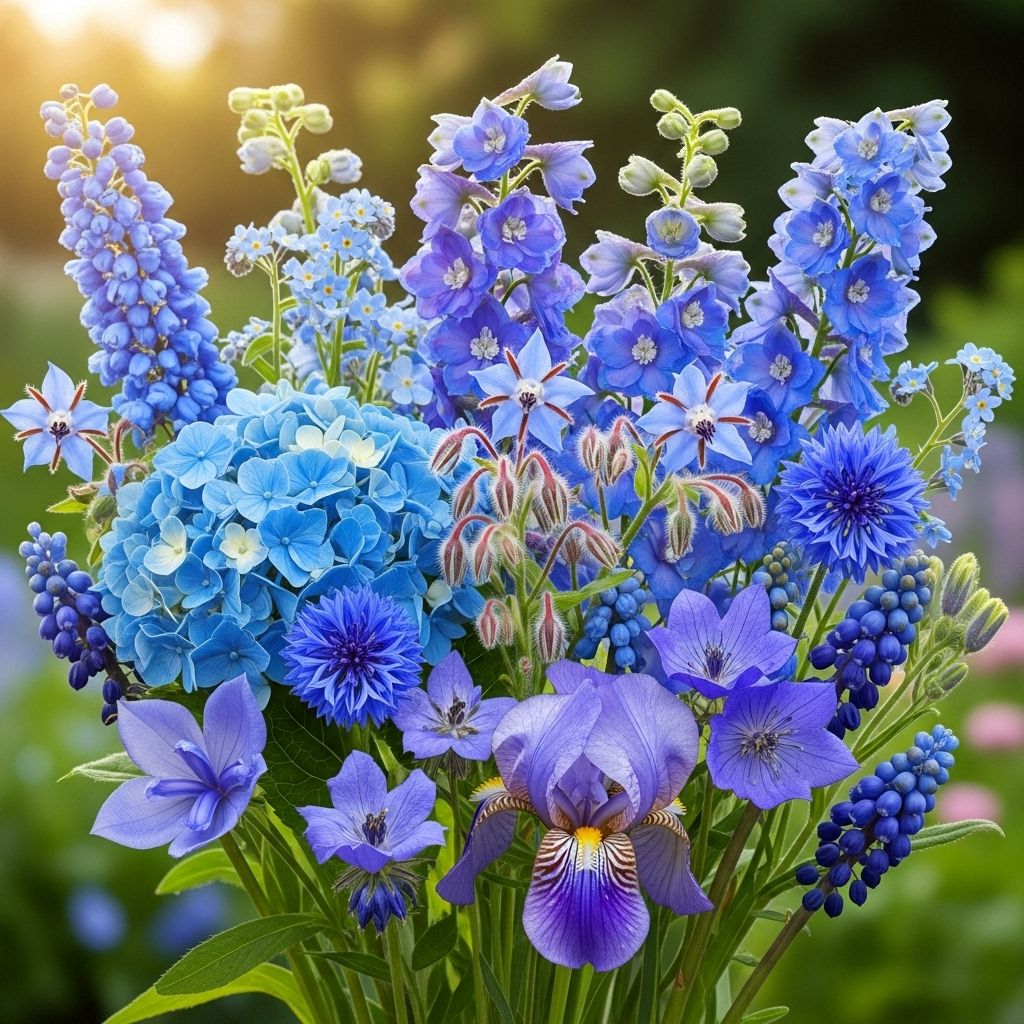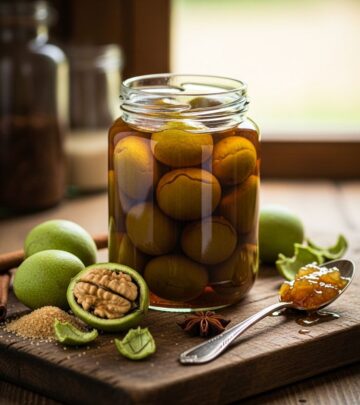8 Stunning Blue Flowers to Brighten Every Garden
These picks bring serene blue hues and draw bees to any outdoor setting.

Image: HearthJunction Design Team
Blue flowers are rare gems in the garden, offering a serene, cooling effect and serving as magnets for pollinators. From airy perennials to tough groundcovers, choosing the right blue bloom elevates beds, borders, and pots by adding dynamic contrast and vibrant color. Here, we showcase eight favorites—each offering unique features, growing advice, and design inspiration for gardeners at every level.
1. Amsonia (Bluestar)
Botanical Name: Amsonia
Amsonia, or Bluestar, produces clusters of petite, star-shaped blue flowers atop slender foliage in late spring. Native to much of the US, Amsonia is prized for its rare, true blue tones and its resilience in varied garden conditions. Its graceful habit gives borders and wildflower gardens a soft, hazy effect.
- Height/Spread: 2–3 feet tall and wide
- Bloom Time: Late spring to early summer
- USDA Zones: 3–9
- Sun/Soil: Full sun to part shade; tolerant of average garden soil
- Wildlife Benefits: Supports pollinators like hawkmoths and butterflies; deer-resistant
Tip: Wear gloves when handling Amsonia, as its sap can irritate sensitive skin.
2. Lithodora
Botanical Name: Lithodora diffusa
Lithodora forms a dense carpet of tiny, intensely blue star-shaped blooms that last for weeks. Its evergreen, slightly fuzzy leaves and low-growing habit make it an attractive groundcover or addition to rock gardens, edging, and even containers where it can trail dramatically.
- Height/Spread: 6–12 inches tall; spreads up to 2 feet
- Bloom Time: Late spring into summer
- USDA Zones: 6–10
- Sun/Soil: Needs sun to partial shade; prefers well-drained, slightly acidic soil; avoid heavy clay
- Pollinator Magnet: Attracts butterflies and small bees
- Maintenance: Prune after flowering to shape and refresh plant
- Bonus: Deer-resistant
3. Delphinium
Botanical Name: Delphinium elatum and hybrids
Towering spikes of electric blue blossoms make Delphinium a dramatic vertical accent in flower gardens. These perennials are garden classics, beloved for their upright form, saturated colors, and appeal in cutting gardens. Supporting the tall, hollow stems is essential to prevent wind and rain damage.
- Height/Spread: 3–6 feet tall, 1–2 feet wide
- Bloom Time: Early to midsummer; may rebloom in cool climates
- USDA Zones: 3–7
- Sun/Soil: Prefers full sun (with afternoon shade in hot areas), rich moist soil
- Design Uses: Back of borders, cutting gardens, cottage style beds
Note: All parts of Delphinium are toxic if ingested; keep away from pets and small children.
4. Pincushion Flower
Botanical Name: Scabiosa caucasica ‘Fama Deep Blue’
This garden favorite produces impressively large, ruffled blue blooms (up to 4 inches across!), making it a valuable addition to borders and pollinator patches. Bees and butterflies are constant visitors, and as a frequent cut flower, it rewards gardeners with more blooms the more they pick.
- Height/Spread: Up to 2 feet tall and wide
- Bloom Time: Late spring through fall
- USDA Zones: 4–9
- Sun/Soil: Full sun; needs well-drained soil to avoid rot
- Features: Long bloom season, excellent cut flower, pollinator-friendly
- Design Uses: Pots, perennial beds, cutting gardens, edging
5. Blue Hydrangea
Botanical Name: Hydrangea macrophylla (Bigleaf hydrangea)
The iconic blue hydrangea graces summer gardens with spectacular mophead or lacecap flower clusters. Flower color often depends on soil pH (acidic soils produce bluer shades)—a detail that fascinates gardeners and can be leveraged for design. Their rich blue hues and ability to shift color make them sought-after for borders, foundation plantings, and floral arrangements.
- Height/Spread: 3–6 feet tall and wide
- Bloom Time: Summer into early fall
- USDA Zones: 5–9
- Sun/Soil: Morning sun, afternoon shade; moist, well-drained soil
- Flower Color Tip: Enrich soil with aluminum sulfate for deeper blue blooms
6. Blue Salvia
Botanical Name: Salvia farinacea and other blue salvias
Blue salvias are mainstays of pollinator gardens and perennial borders, producing spires of violet-blue blooms held above aromatic foliage. These easy-to-grow perennials or annuals thrive in sunny, well-drained sites and flower freely, often until frost. Their drought-tolerance and pest resistance make them reliable performers.
- Height/Spread: 1–3 feet tall, 12–18 inches wide depending on the variety
- Bloom Time: Late spring to frost
- USDA Zones: 8–10 (annual in colder areas)
- Sun/Soil: Needs full sun; average soil; prefers good drainage
- Wildlife: Attracts bees, butterflies, and hummingbirds
7. Spring Starflower
Botanical Name: Ipheion uniflorum
Spring starflower is a charming bulb that covers the ground with delicate, starry light blue blooms in early spring. It naturalizes readily, forming cheerful carpets under trees, in borders, or rock gardens. Its sweet fragrance and easy care make it a perfect choice for brightening up spring landscapes.
- Height/Spread: 4–6 inches tall, spreads as a colony
- Bloom Time: Mid to late spring
- USDA Zones: 5–9
- Sun/Soil: Best in full sun to part shade; well-drained soil
- Design Uses: Lawns, under deciduous trees/shrubs, rock gardens
8. Borage
Botanical Name: Borago officinalis
Borage celebrates summer with vivid, star-shaped blue flowers that bees adore. This old-fashioned annual herb offers edible blooms with a cucumber flavor, suitable for scattered in salads or as a cocktail garnish. It grows rapidly, reseeds freely if spent blooms are left standing, and makes a vibrant companion in vegetable plots or orchards where pollinator activity boosts productivity.
- Height/Spread: About 1 foot tall, sprawling habit
- Bloom Time: Late spring through summer
- USDA Zones: 3–10 (grown as an annual)
- Sun/Soil: Full sun to partial sun; tolerates a range of soils
- Pollinator Benefits: Outstanding nectar source for bees
- Edible Uses: Flowers can be added to salads and drinks
Comparison Table of Featured Blue Flowers
| Flower Name | Height | Bloom Time | Best Use | Pollinator Value |
|---|---|---|---|---|
| Amsonia | 2–3 ft | Late Spring | Borders, native gardens | Butterflies, hummingbirds |
| Lithodora | 6–12 in | Late Spring–Summer | Groundcover, containers | Butterflies, bees |
| Delphinium | 3–6 ft | Early–Mid Summer | Cut flowers, back borders | Bees, hummingbirds |
| Pincushion Flower | 2 ft | Spring–Fall | Edging, cutting, pots | Bees, butterflies |
| Hydrangea | 3–6 ft | Summer–Fall | Foundation, borders, cut | Some bees |
| Blue Salvia | 1–3 ft | Late Spring–Frost | Borders, pollinator beds | Bees, butterflies |
| Spring Starflower | 4–6 in | Mid–Late Spring | Naturalizing, understory | Early pollinators |
| Borage | 1 ft | Late Spring–Summer | Veg gardens, herbal use | Bees |
Design Tips and Companion Planting
Blue flowers enhance gardens not only by color, but also by calming hot-colored schemes, creating depth, and attracting essential pollinators. Below are ways to use them for maximum effect:
- Contrast for Impact: Pair blue blooms with oranges, yellows, or reds for high-contrast drama.
- Monochrome Calm: Combine different blue-flowering plants for a soothing, unified look.
- Pollinator Gardens: Group blue-flowering species together with lavender, thyme, and calendula to create bee-friendly spaces.
- Understory & Borders: Use starflowers or lithodora to highlight pathways or edge mixed beds.
- Groundcovers: Lithodora and starflower work well under shrubs or mixed in rock gardens.
Frequently Asked Questions (FAQs)
Q: Why are true blue flowers rare in nature?
A: Blue pigmentation is genetically rare among flowering plants—most ‘blue’ flowers use optical tricks and pigment combinations to appear blue, but truly blue pigments are scarce in the plant kingdom.
Q: Which blue flower attracts the most pollinators?
A: Borage stands out as a top bee magnet, but pincushion flower, blue salvia, and lithodora are also excellent choices for attracting a wide range of pollinators including bees, butterflies, and hummingbirds.
Q: Can I change a hydrangea’s color to blue?
A: Yes! Adding aluminum sulfate to the soil lowers pH, making macrophylla hydrangeas turn bluer—soil pH below 5.5 is ideal.
Q: Are blue flowers more difficult to grow than other colors?
A: Not necessarily. Many blue-flowering plants—like Amsonia, borage, and spring starflower—are as easy to grow as their white or pink relatives, provided you meet their soil, water, and sun requirements.
Q: Can blue flowers grow in containers or small spaces?
A: Absolutely. Lithodora, pincushion flower, spring starflower, and blue salvia thrive in containers or small garden plots. Ensure well-drained potting mix and sufficient sun for best color and flowering.
Add a Splash of Blue: Final Tips
Few sights rival the serene power of blue flowers glowing at dusk or shimmering against green foliage. Experiment with plant combinations, use soil amendments where needed, and always allow for a few naturalizing species to spread for a ‘sea of blue’. Whether for bees, bold borders, or pure visual delight, blue blooms are truly garden treasures worth celebrating.
References
- https://www.gardenia.net/guide/plants-with-blue-flowers-to-enhance-your-garden-beauty
- https://www.gardenista.com/posts/8-favorites-blue-flowers/
- https://www.gardenista.com/posts/gardening-101-bluestar-amsonia/
- https://www.gardenista.com/posts/gardening-101-lithodora/
- https://www.gardenista.com/posts/african-blue-basil/
Read full bio of Anjali Sayee












